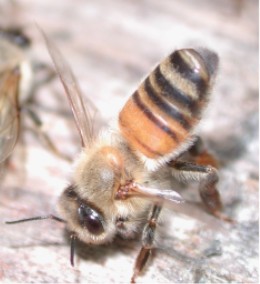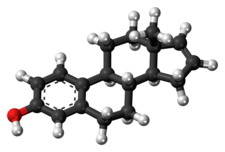
A pheromone is a secreted or excreted chemical factor that triggers a social response in members of the same species. Pheromones are chemicals capable of acting like hormones outside the body of the secreting individual, to affect the behavior of the receiving individuals. There are alarm pheromones, food trail pheromones, sex pheromones, and many others that affect behavior or physiology. Pheromones are used by many organisms, from basic unicellular prokaryotes to complex multicellular eukaryotes. Their use among insects has been particularly well documented. In addition, some vertebrates, plants and ciliates communicate by using pheromones. The ecological functions and evolution of pheromones are a major topic of research in the field of chemical ecology.

Estrone (E1), also spelled oestrone, is a steroid, a weak estrogen, and a minor female sex hormone. It is one of three major endogenous estrogens, the others being estradiol and estriol. Estrone, as well as the other estrogens, are synthesized from cholesterol and secreted mainly from the gonads, though they can also be formed from adrenal androgens in adipose tissue. Relative to estradiol, both estrone and estriol have far weaker activity as estrogens. Estrone can be converted into estradiol, and serves mainly as a precursor or metabolic intermediate of estradiol. It is both a precursor and metabolite of estradiol.

Estriol (E3), also spelled oestriol, is a steroid, a weak estrogen, and a minor female sex hormone. It is one of three major endogenous estrogens, the others being estradiol and estrone. Levels of estriol in women who are not pregnant are almost undetectable. However, during pregnancy, estriol is synthesized in very high quantities by the placenta and is the most produced estrogen in the body by far, although circulating levels of estriol are similar to those of other estrogens due to a relatively high rate of metabolism and excretion. Relative to estradiol, both estriol and estrone have far weaker activity as estrogens.
Body odor or body odour (BO) is present in all animals and its intensity can be influenced by many factors. Body odor has a strong genetic basis, but can also be strongly influenced by various factors, such as gender, diet, health, and medication. The body odor of human males plays an important role in human sexual attraction, as a powerful indicator of MHC/HLA heterozygosity. Significant evidence suggests that women are attracted to men whose body odor is different from theirs, indicating that they have immune genes that are different from their own, which may produce healthier offspring.
The "gay bomb" refers to a non-lethal psychochemical weapon concept that was speculated upon by a research laboratory within the United States Air Force. This unconventional idea involved the dispersion of sex pheromones over enemy forces, with the intent of generating mutual sexual attraction among them causing mass confusion and panic within their platoons.

Androstenol, also known as 5α-androst-16-en-3α-ol, is a 16-androstene class steroidal pheromone and neurosteroid in humans and other mammals, notably pigs. It possesses a characteristic musk-like odor.
Gender incongruence is the state of having a gender identity that does not correspond to one's sex assigned at birth. This is experienced by people who identify as transgender or transsexual, and often results in gender dysphoria. The causes of gender incongruence have been studied for decades.
The Lee–Boot effect is a phenomenon concerning the suppression or prolongation of oestrous cycles of mature female mice, when females are housed in groups and isolated from males. It is caused by the effects of an estrogen-dependent pheromone, possibly 2,5-dimethylpyrazine, which is released via the urine and acts on the vomeronasal organ of recipients. This pheromone lowers the concentration of luteinizing hormone and elevates prolactin levels, synchronising or stopping the recipient's cycle. This effect goes some way to explain why spontaneous pseudopregnancy can occur in mice. The same response is invoked from isolated females when brought into contact with urine-soaked bedding from other females' cages. The adrenal glands are required for production of the urine pheromone which is responsible for this effect.

Androstadienone, or androsta-4,16-dien-3-one, is a 16-androstene class endogenous steroid that has been described as having potent pheromone-like activities in humans. The compound is synthesized from androstadienol by 3β-hydroxysteroid dehydrogenase, and can be converted into androstenone by 5α-reductase, which can subsequently be converted into 3α-androstenol or 3β-androstenol by 3-ketosteroid reductase.

Epiandrosterone, or isoandrosterone, also known as 3β-androsterone, 3β-hydroxy-5α-androstan-17-one, or 5α-androstan-3β-ol-17-one, is a steroid hormone with weak androgenic activity. It is a metabolite of testosterone and dihydrotestosterone (DHT). It was first isolated in 1931, by Adolf Friedrich Johann Butenandt and Kurt Tscherning. They distilled over 17,000 litres of male urine, from which they got 50 milligrams of crystalline androsterone, which was sufficient to find that the chemical formula was very similar to estrone.
Odour is sensory stimulation of the olfactory membrane of the nose by a group of molecules. Certain body odours are connected to human sexual attraction. Humans can make use of body odour subconsciously to identify whether a potential mate will pass on favourable traits to their offspring. Body odour may provide significant cues about the genetic quality, health and reproductive success of a potential mate.

The Great Pheromone Myth is a book on pheromones and their application to chemosensation in mammals by Richard L. Doty, director of the University of Pennsylvania's Smell and Taste Center in Philadelphia. Doty argues that the concept of pheromone introduced by Karlson and Lüscher is too simple for mammalian chemonsensory systems, failing to take into account learning and the context-dependence of chemosensation. In this book, he is especially critical of human pheromones, arguing that not only are there no definitive studies finding human pheromones, but that humans lack a functional vomeronasal organ to detect pheromones. Its publication received coverage in the news media, especially concerning its arguments that human pheromones do not exist.

Androstadienol, or androsta-5,16-dien-3β-ol, is a 16-androstene class endogenous steroid, pheromone, and chemical intermediate to several other pheromones that is found in the sweat of both men and women.

17α-Estradiol is a minor and weak endogenous steroidal estrogen that is related to 17β-estradiol. It is the C17 epimer of estradiol. It has approximately 100-fold lower estrogenic potency than 17β-estradiol. The compound shows preferential affinity for the ERα over the ERβ. Although 17α-estradiol is far weaker than 17β-estradiol as an agonist of the nuclear estrogen receptors, it has been found to bind to and activate the brain-expressed ER-X with a greater potency than that of 17β-estradiol, suggesting that it may be the predominant endogenous ligand for the receptor.

Aminoestradiol (AE2), also known as 17β-aminoestradiol (17βAE2) or as 17β-aminoestra-1,3,5(10)-trien-3-ol, is a synthetic, steroidal estrogen and a 17β-aminoestrogen with anticoagulant effects that was never marketed. It is an analogue of estradiol in which the C17β hydroxyl group has been replaced with an amine group. AE2 has profoundly reduced estrogenic potency compared to estradiol; its EC50 for activation of the ERα was found to be 1.82 μM, whereas that of estradiol was 2.14 nM (relative potency 0.12 for AE2 versus 100 for estradiol, or roughly a 1,000-fold difference). It binds with low relative affinity to both the ERα and ERβ and has estrogenic activity that is greatly mediated through the ERβ and to a lesser extent through the ERα.

In zoology, copulation is animal sexual behavior in which a male introduces sperm into the female's body, especially directly into her reproductive tract. This is an aspect of mating. Many animals that live in water use external fertilization, whereas internal fertilization may have developed from a need to maintain gametes in a liquid medium in the Late Ordovician epoch. Internal fertilization with many vertebrates occurs via cloacal copulation, known as cloacal kiss, while mammals copulate vaginally, and many basal vertebrates reproduce sexually with external fertilization.

Estrin, or oestrin, also known as estra-1,3,5(10)-triene, is an estrane steroid. It is dehydrogenated estrane with double bonds specifically at the C1, C3, and C5(10) positions. Estrin is a parent structure of the estrogen steroid hormones estradiol, estrone, and estriol, which have also been known as dihydroxyestrin, ketohydroxyestrin, and trihydroxyestrin, respectively.
The Hoover-Drickamer effect occurs when adult female mice are exposed to the urine of pregnant and lactating adult female mice, resulting in a longer than typical oestrus period. The effect was first noted by J. E. Hoover and L. C. Drickamer in their 1979 study wherein they randomly assigned adult female mice to one of four treatment conditions: a control group where the subjects were exposed to water, a group that was exposed to the urine of pregnant mice, a group that was exposed to the urine of lactating mice and a group that was exposed to the urine of a singly caged female mouse.

Estriol sulfamate, or estriol 3-O-sulfamate, is a synthetic estrogen and estrogen ester which was never marketed. It is the C3 sulfamate ester of estriol. The drug shows substantially improved oral estrogenic potency relative to estriol in rats but without an increase in hepatic estrogenic potency. However, the closely related compound estradiol sulfamate (E2MATE) failed to show estrogenic activity in humans, which is due to the fact that it is additionally a highly potent inhibitor of steroid sulfatase which regulates the estrogenicity of such compounds and thus it prevents its own bioactivation into estradiol.

Trestolone enanthate, also known as 7α-methyl-19-nortestosterone 17β-enanthate, is an androgen and anabolic steroid (AAS) and progestogen which was never marketed. It is an androgen ester; specifically, it is the C17β enanthate (heptanoate) ester of trestolone (7α-methylestr-4-en-17β-ol-3-one). Trestolone enanthate has low affinity for sex hormone-binding globulin (SHBG), similarly to testosterone enanthate.














